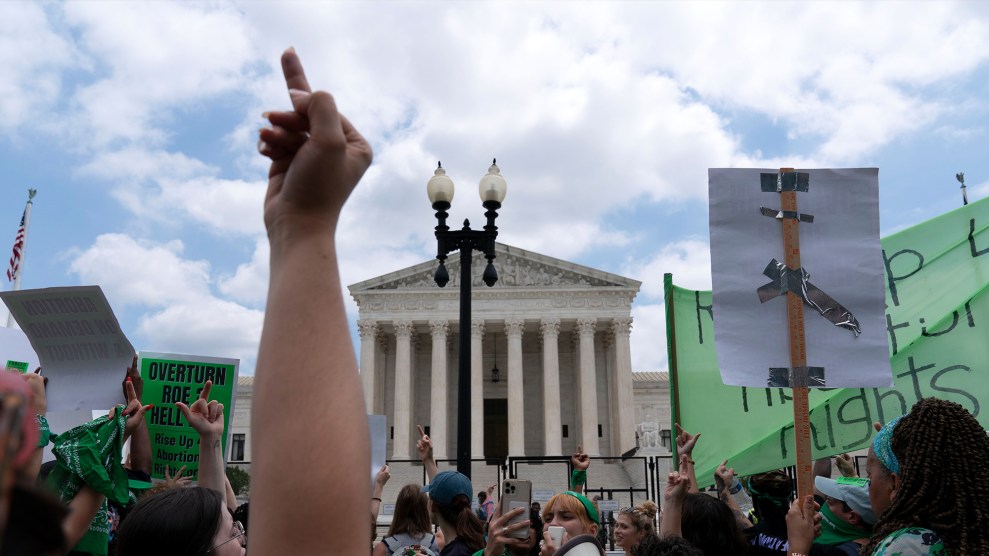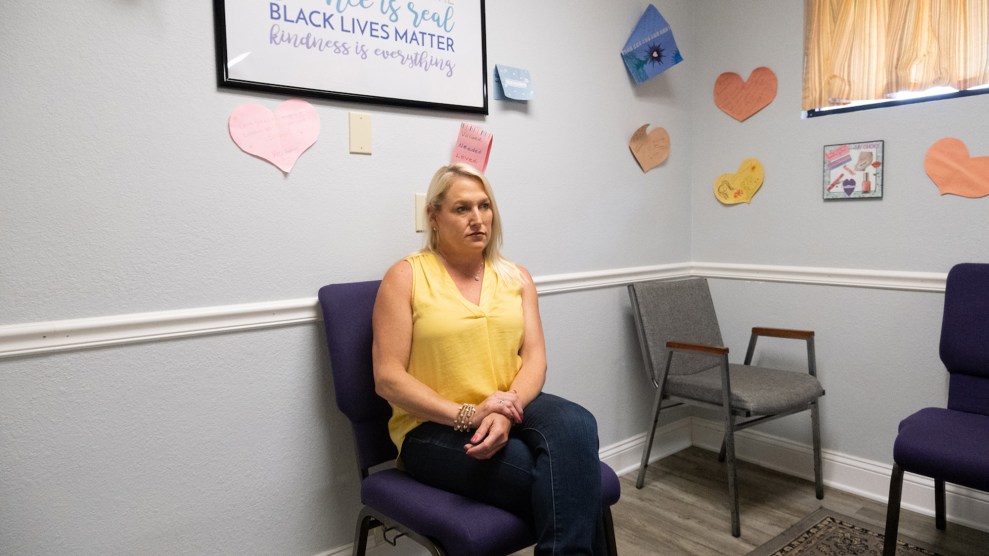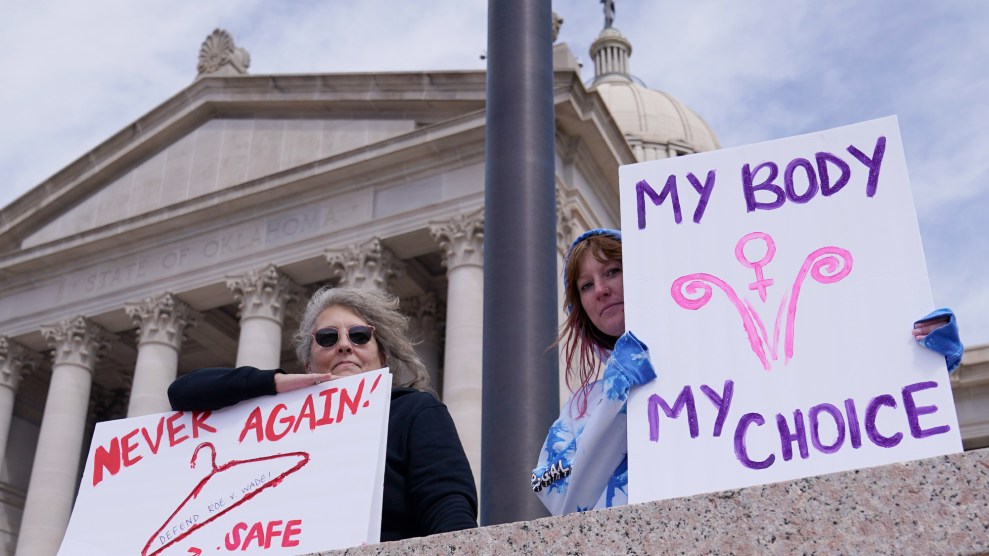
Mother Jones illustration; Getty
When Emily and Mike Allen got married in 2009, they immediately started trying for a baby—at 32, Emily was eager to become a parent. But as it turned out, she would have to wait. Pregnancy didn’t happen naturally, so the Allens sought help from a fertility clinic. One failed cycle followed another, and after six attempts at intrauterine insemination, four IVF cycles, and tens of thousands of dollars, the Allens (whose real names I’m not using to protect their privacy) decided to use eggs from a donor. After the cycle was complete, they got the first good baby news they’d had in years: there were three textbook-perfect embryos, one of which the doctor transferred to Emily’s uterus. Ten years after they had started trying, Emily was finally expecting. They froze the other two embryos, just in case something went wrong with the pregnancy. “At the time, I thought about it like an insurance policy,” recalls Emily. But they didn’t end up needing any extras: In 2019, Violet was born.
The Allens were overjoyed—and, like most new parents, completely exhausted. It didn’t help that by this point, Emily was 42, and Mike was 53—with two grown children from a previous marriage. As Violet grew, the couple decided together that given their respective ages, they probably wouldn’t try for another baby. Still, Emily didn’t want to ask the clinic to discard the extra embryos yet. What if they changed their minds? So they kept putting off the final decision, paying more than $600 a year to store them.
Then, in the last few months, two unrelated events lent a certain urgency to this decision: First, the clinic raised its storage fees to nearly $1,000 a year. Then, the Supreme Court overturned the landmark case of Roe v. Wade, enacting trigger laws that will make abortion illegal in many states, including Georgia, where the Allens live. The fall of Roe could also be disastrous for IVF: Since the process often produces extra embryos, which for the anti-choice movement still constitute life that should be protected, states may decide to impose restrictions on the practice or outlaw it altogether. But regardless of what happens to IVF, there is the question of the fate of the embryos that are currently being stored, and who will pay for that storage if the creators of the embryos can’t.
For the time being, given the vast and unsettled implications of the Supreme Court’s ruling on abortion, the Allens can still legally discard their embryos. But Emily, who considers herself pro-choice, wondered what this decision would mean for her embryos. She had heard from social media that the option to discard the embryos could soon no longer exist, and that couples with embryos in storage could end up paying their storage fees forever. Plus, there’s an unexpected psychological aspect for Emily: She simply doesn’t feel ready to let them go. “The Roe decision does add some uncertainty,” she told me. “Will I lose the chance to have them thaw those embryos and say goodbye?”
For anti-abortion activists, however, no such ambivalence exists: Frozen embryos should be considered people. In cases where divorced couples disagree on the fate of their frozen embryos, these groups have offered legal support to individuals who are against the idea of discarding them. In 2016, Thomas Olp, a prominent anti-choice lawyer who has been involved in these curious custody battles, told the New York Times, “Husbands and wives can divide up their property however they want, but embryos are living beings, so the legal standard has to be what’s in their best interest.”
Of the half-dozen anti-choice activists I reached out to for this story, Herb Geraghty, the president of the Pittsburgh-based group Rehumanize International, was the only one who agreed to an interview. Unlike many other anti-abortion organizations, Rehumanize is a secular group, and it promotes what it refers to as a “consistent life ethic,” advocating against the death penalty and gun violence as well as abortion. Geraghty acknowledged that he doesn’t know exactly what should be done with the “thousands of human beings who are currently frozen against their will.” But he does know that he is adamantly against the idea of disposing of them. “We should not intentionally end the life of a human being, regardless of where they are in their lifecycle, in a womb or in a fertility lab.”
No one knows exactly how many embryos are in the hundreds of fertility clinics across the nation—estimates range from 400,000 to a million. Will embryo disposal soon be considered abortion in certain states? Timothy Hickman, a reproductive endocrinologist in Houston, Texas, who also serves as the president of the American Society for Reproductive Medicine, hopes that lawmakers will make an exception for IVF embryos, “after people figure out how important this is to the people that are trying to build their families.” But, he continued, “My fear is that there might be a time of this confusion until enough people speak out about it saying, ‘Hey, this can’t happen.’”
The anti-abortion movement has never liked the idea of frozen embryos—activists portray people who go through IVF as entitled narcissists who are playing God, creating dozens of embryos just so they can hand pick their children’s gender and eye color. “Human beings are treated as products that parents can design, build, and destroy to satisfy their own desires,” thundered a 2019 article titled “‘Leftover children’: Three Tragic Problems With in-Vitro Fertilization” by the anti-choice group Live Action.
But the reality of IVF is more complicated, says Lucky Sekhon, a reproductive endocrinologist with Reproductive Medicine Associates of New York. In a typical IVF cycle, a woman takes hormonal medications to encourage her ovaries to produce as many eggs as possible. When the eggs are mature, the doctor retrieves them and combines them with sperm to make embryos. The problem is that human reproduction is woefully inefficient: It’s common for many of the embryos created to be abnormal, and the proportion of nonviable embryos increases as a woman ages. “What the lawmakers who are making these decisions don’t understand is that most of the chromosomal problems that we commonly see in embryos lead to miscarriage,” says Sekhon. “These are embryos that are not compatible with life.” As a general rule, the greater the number of normal embryos created, the higher the chances of a live birth.
You could, of course, transfer all the embryos that you create, in hopes that one would stick—and in fact, that’s how IVF used to be done, before embryo-freezing technology advanced. But what if four or five or more embryos implant? Carrying more than one fetus carries significant risk for both mother and babies. For that reason, the current standard of care for most IVF patients is to transfer one embryo at a time into a uterus and freeze the remaining ones as back-ups—or potential future siblings.
Now that the Supreme Court has overturned Roe, the fate of those embryos is unclear. In one of the more apocalyptic scenarios being bandied about on Twitter, IVF patients could be required by law to transfer all of their embryos to their wombs—in some cases, that could be as many as several dozen. The reproductive endocrinologists I spoke with believe that’s unlikely. More realistically, embryos might be transferred to states where abortion is still legal—at the patient’s expense, of course—and either stored or disposed of there.
Geraghty, the anti-abortion activist, favors a third option: He believes that IVF patients who have embryos with unpaid storage fees should donate them to families who want to have children—a process he refers to as “embryo adoption.” This idea is not original to him. In fact, anti-abortion groups have long urged families to donate their extra embryos instead of discarding them. So persuasive have they been that the US Department of Health and Human Services now supports their efforts with federal funds, about $1 million a year, since George W. Bush created the program in 2001. “If you have remaining embryos, you should be able to feel comfortable with the future for those em-babies,” Embryo Connections, one of the agencies that receives government funding match families with embryos, announces on its website. “We’ll make this part easy for you, so that you can get back to your precious children!” Another, called Embryo Solution, assures potential embryo recipients, “By choosing embryo adoption, you are rescuing embryos that have already been created. You are offering a chance at life!”
Sekhon, the reproductive endocrinologist in New York, called the idea of forced embryo donation “ridiculous.” While a small number of patients do choose to donate their unused embryos, most are uncomfortable with that idea. “Because those embryos were created with the intent of building a family,” she says, “that family may not have considered or desired the potential of many full siblings growing up in other families.”
Emily Allen says her husband would like to move forward with discarding the embryos while that’s still an option. They could put the escalating storage fees toward Violet’s education instead. In theory, Emily agrees. She supports abortion rights, and she doesn’t believe that an embryo is the same as a person, especially if it’s not even in a uterus. Yet after all she went through, she still feels a wave of sadness when she thinks about discarding them.
Sekhon says that many of her patients feel the same way. The process of IVF is often long and expensive, and fraught with grief and sadness. “It’s really natural to have feelings about these embryos that you worked so hard to create, while at the same time recognizing that other people’s situations are different,” she says.
Sometimes, Emily thinks about asking her clinic to transfer her remaining embryos into her uterus without taking any of the hormonal medications required for an IVF pregnancy—that way, it would be nearly impossible for the embryos to implant, but she would still have a final connection with them. There’s a major downside to that idea, though: it would cost about $4,000. Other times, she thinks about asking the clinic to release her remaining two embryos to her so that she can take them home and maybe say goodbye with a ceremony under a favorite tree.
Whether or not the clinic would let her do that, much less whether it would be allowed once abortion is no longer legal in Georgia, is unknown. But for now, Emily isn’t thinking much about all the potential legal logistics. She’s just trying to navigate her own emotions around the fate of her embryos. It has been more difficult than she had imagined. “I feel stuck,” she says. “I am really trying to find peace around this.”
















